| dc.contributor.author | Mitchell, Rebecca | |
| dc.contributor.author | Gordon, Jessica | |
| dc.contributor.author | Bhoi, Gopal Krushna | |
| dc.contributor.author | Nisbett, Nicholas | |
| dc.coverage.spatial | India | en |
| dc.date.accessioned | 2023-05-30T11:51:27Z | |
| dc.date.available | 2023-05-30T11:51:27Z | |
| dc.date.issued | 2023-04-04 | |
| dc.identifier.citation | Mitchell, R., Nisbett, N., Bhoi, G.K. and Gordon, J. (2023) ‘Applying the "Candidacy" Model to Understand Access to Key Nutrition, Food & Health Services in LMIC Contexts: a Qualitative Study in Odisha, India’, Food Security, (2023) 15:649–660, DOI: 10.1007/s12571-023-01357-5 | en |
| dc.identifier.uri | https://opendocs.ids.ac.uk/opendocs/handle/20.500.12413/18003 | |
| dc.description.abstract | In order to make progress towards Sustainable Development Goal 2 – Zero Hunger – we must acquire a better understanding of what continues to hamper achieving food security, particularly in contexts where progress has been achieved, but has then faltered. This article investigates access to nutrition and food services in three of the Indian state of Odisha’s traditionally poorer districts, where a large number of the state’s most marginalised populations live. Semi-structured interviews were carried out in 11 villages. The Dixon-Woods Candidacy Model was employed to provide greater insight into the experiences of access to health and nutrition services, from both the supply and the demand sides. We found that there are many points along the journey that hamper access. We identified two levels of gatekeepers that can create (or remove) barriers, the first as front-line service providers and the second as high-level officials. The candidacy model shows that marginalisation caused by identity, poverty and education disparities hampers progress throughout this journey. This article aims to provide a view to improve our understanding of access to health, food and nutrition services, to improve food security, and to show the value of the candidacy model applied to an LMIC health setting. | en |
| dc.description.sponsorship | CGIAR Research Program on Agriculture for Nutrition and Health | en |
| dc.language.iso | en | en |
| dc.publisher | Springer | en |
| dc.rights.uri | http://creativecommons.org/licenses/by/4.0/ | en |
| dc.subject | Health | en |
| dc.title | Applying the ‘Candidacy’ Model to Understand Access to Key Nutrition, Food & Health Services in LMIC Contexts: a Qualitative Study in Odisha, India | en |
| dc.type | Article | en |
| dc.rights.holder | © The Author(s) 2023 | en |
| dc.identifier.externaluri | https://link.springer.com/article/10.1007/s12571-023-01357-5 | en |
| dc.identifier.team | Health and Nutrition | en |
| dc.identifier.doi | 10.1007/s12571-023-01357-5 | |
| dcterms.dateAccepted | 2023-01-17 | |
| rioxxterms.funder | Default funder | en |
| rioxxterms.identifier.project | NH/17036 | en |
| rioxxterms.version | VoR | en |
| rioxxterms.versionofrecord | 10.1007/s12571-023-01357-5 | en |
| rioxxterms.funder.project | 23ddaaf1-f79f-41d0-8dcc-26c4a1367a92 | en |


